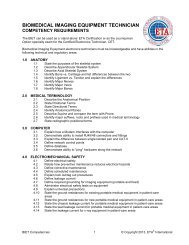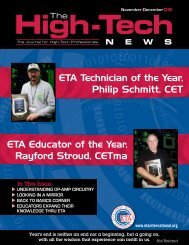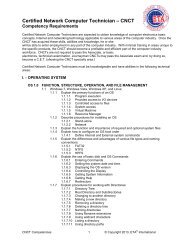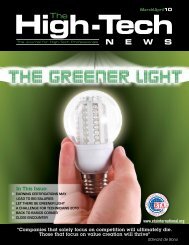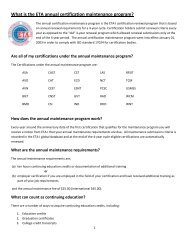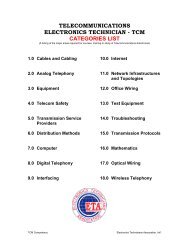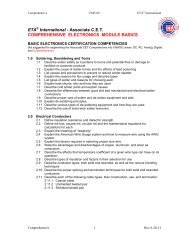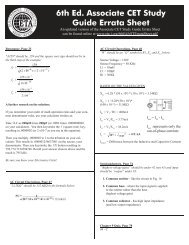Gaming & Vending Technician (GVT) - ETA International
Gaming & Vending Technician (GVT) - ETA International
Gaming & Vending Technician (GVT) - ETA International
Create successful ePaper yourself
Turn your PDF publications into a flip-book with our unique Google optimized e-Paper software.
<strong>ETA</strong> ® <strong>International</strong> – <strong>Gaming</strong> and <strong>Vending</strong> <strong>Technician</strong><br />
GAMING AND VENDING TECHNICIAN - <strong>GVT</strong><br />
Competency Requirements<br />
The following is a listing of the major categories and items considered necessary to be<br />
included in a course of study directed towards the education of workers needed in the<br />
gaming and vending repair industry.<br />
The <strong>Gaming</strong> and <strong>Vending</strong> <strong>Technician</strong> will be required to properly perform the following:<br />
Money Handling<br />
Electrical Fundamentals<br />
Basic Electronics Concepts<br />
Computer Hardware, Networking, and Display Technologies<br />
Safety Precautions and Protection<br />
The <strong>Gaming</strong> and <strong>Vending</strong> <strong>Technician</strong> will be required to properly understand safe working practices for:<br />
Electrical safety<br />
Certification examination questions and skill demonstrations (when required) are based on the curriculum and syllabus<br />
provided in the specific COMPETENCIES LIST.<br />
There are 5 general categories of required knowledge and skills. The COMPETENCY LISTING defines the particular<br />
content areas in which the certification candidate must demonstrate proficiency.<br />
1.0 MONEY HANDLING<br />
1.1 Coin Handling<br />
1.1.1 Describe Coin Acceptor Operation<br />
1.1.2 Explain Coin Acceptor denomination conversions<br />
1.2 Bill Handling<br />
1.2.1 Describe Bill Acceptor operation<br />
1.2.2 Describe methods of bill validation<br />
1.2.3 Explain Bill travel<br />
1.2.4 Explain Bill storage<br />
1.3 Ticket<br />
1.3.1 Describe Ticket Acceptance<br />
1.4 Money Dispensing<br />
1.4.1 Explain hopper operation<br />
2.0 ELECTRICAL FUNDAMENTALS<br />
2.1 Electrical Terms<br />
2.1.1 Describe atomic structure, the components of the atom, and charges<br />
2.1.1.1 Describe the importance to electrical technology<br />
2.1.2 Identify the following electrical components, their symbols and their usages:<br />
2.1.2.1 Resistors<br />
2.1.2.2 Insulators<br />
2.1.2.3 Conductors<br />
2.1.2.4 Switches<br />
2.1.2.4.1 Describe the different types of switches<br />
2.1.2.4.2 Explain what a micro switch is and its usage<br />
2.1.2.5 Fuses<br />
2.1.2.6 Circuit Breakers<br />
2.1.2.7 Batteries<br />
2.1.2.8 Coils<br />
2.1.2.8.1 Identify the differences between a Solenoid coil and a Relay coil<br />
2.1.2.9 Transformers<br />
2.1.2.9.1 Identify the types and usage<br />
2.2 Ohms Law<br />
<strong>GVT</strong> Competencies 1 © Copyright 2013, <strong>ETA</strong> ® <strong>International</strong>
<strong>ETA</strong> ® <strong>International</strong> – <strong>Gaming</strong> and <strong>Vending</strong> <strong>Technician</strong><br />
2.2.1 Summarize Ohms Law<br />
2.2.2 Describe the following electronic measurements:<br />
2.2.2.1 Voltage<br />
2.2.2.2 Current<br />
2.2.2.3 Resistance<br />
2.2.3 Describe the basic Series circuit<br />
2.2.4 Describe the basic Parallel circuit<br />
2.2.5 Calculate current, voltage or resistance using Ohms Law in a Series Circuit<br />
2.3 Multimeter<br />
2.3.1 Explain multi-meter construction, components and usage<br />
2.3.2 Describe how to make a proper Ohms reading<br />
2.3.3 Describe the difference between a Continuity reading and an Ohm reading<br />
2.3.4 Describe how to make a proper DC and AC voltage reading<br />
2.3.5 Describe how to make a proper DC and AC amp reading<br />
2.4 Connectors<br />
2.4.1 Describe the two basic crimpers used on connectors<br />
3.0 BASIC ELECTRONICS CONCEPTS<br />
3.1 Electronic Components<br />
3.1.1 Identify the following electronic components and their usage<br />
3.1.1.1 Capacitor<br />
3.1.1.1.1 Describe the different types and the values assigned to them<br />
3.1.1.2 Resistor<br />
3.1.1.2.1 Identify a load resistor in a circuit<br />
3.1.1.2.2 Identify a voltage divider circuit<br />
3.1.1.2.3 Identify a pull up resistor<br />
3.1.1.2.4 Identify a dropping resistor<br />
3.1.1.3 Semi-conductors<br />
3.1.1.3.1 Describe the characteristics of a semi conductor<br />
3.1.1.3.2 Define the values of saturation for the two type semi conductors<br />
3.1.1.3.3 Describe the function of the following components, their terminals<br />
and polarities:<br />
3.1.1.3.3.1 Diodes<br />
3.1.1.3.3.2 LEDs<br />
3.1.1.3.3.3 Zener<br />
3.1.1.3.3.4 Transistor<br />
3.1.1.3.3.5 Darlington<br />
3.1.1.3.3.6 Diac<br />
3.1.1.3.3.7 SCR<br />
3.1.1.3.3.8 IC Voltage regulator<br />
3.1.1.3.3.9 Op Amp<br />
3.1.1.3.3.10 Full wave rectifier<br />
3.1.1.4 Digital Concepts<br />
3.1.1.4.1 List the different types of Logic Gates and their predominant input<br />
signals<br />
3.1.1.4.2 List the logic levels used<br />
3.1.1.4.3 Summarize IC chip power up configurations<br />
3.1.1.4.4 Explain how to determine leg configuration of an IC chip<br />
3.1.1.4.5 Define Flip Flop<br />
3.1.1.4.6 Define the operation and characteristics of a R/S and D Flip Flop<br />
3.1.1.4.7 Explain the different packaging used for multiple components<br />
4.0 COMPUTER HARDWARE, NETWORKING, AND DISPLAY TECHNOLOGIES<br />
4.1 Cabling<br />
4.1.1 Describe physical characteristics and useful properties of USB connectors<br />
4.1.2 Describe the two RJ45 cables<br />
<strong>GVT</strong> Competencies 2 © Copyright 2013, <strong>ETA</strong> ® <strong>International</strong>
<strong>ETA</strong> ® <strong>International</strong> – <strong>Gaming</strong> and <strong>Vending</strong> <strong>Technician</strong><br />
4.2 Computer codes<br />
4.2.1 Perform Binary to Decimal conversions<br />
4.2.2 Perform Binary to Hex conversions<br />
4.2.3 Perform Hex to Funny Hex conversions<br />
4.2.4 Perform Hex to Decimal conversions<br />
4.3 Processor<br />
4.3.1 Name and explain the functions of the internal sections of the microprocessor<br />
4.3.2 Name and explain some of the predominant external lines of the microprocessor<br />
4.4 Memory<br />
4.4.1 Name and describe some memory components and devices used<br />
4.5 Power Supplies<br />
4.5.1 Perform voltage test<br />
4.5.2 Describe basic power supply circuit<br />
4.6 Computer concerns<br />
4.6.1 Describe the causes and effects of static electricity<br />
4.6.2 Describe the causes and effects of electromagnetic interference<br />
4.6.3 Describe the purpose of heat sinks, heat transfer paste and fans<br />
4.7 Networking Technologies<br />
4.7.1 Explain and draw a diagram of the following Network Topologies:<br />
4.7.1.1 Star<br />
4.7.1.2 Token Ring<br />
4.7.1.3 Mesh<br />
4.8 Displays<br />
4.8.1 Describe monitor operation<br />
4.8.2 Describe flat screen display<br />
4.8.3 Explain touch screen operation<br />
5.0 SAFETY PRECAUTIONS AND PROTECTION<br />
5.1 Electrical Safety<br />
5.1.1 Describe personal safety precautions for working with electric and electronic devices<br />
5.1.2 Recognize, evaluate, and control electrical hazards<br />
5.1.3 Identify the hazards of electric shock<br />
5.1.4 Describe the human physiological reactions electrical shock causes<br />
5.1.5 List various degrees of current the human body can tolerate<br />
5.1.6 Explain proper lockout/tagout procedures<br />
5.2 Personal Protective Equipment<br />
5.2.1 Explain proper eye protection procedures<br />
5.2.2 Explain proper use of the hard hat<br />
5.2.3 Explain proper foot protection techniques<br />
5.2.4 Explain proper use of protective clothing<br />
5.3 Fire Safety<br />
5.3.1 Evaluate emergency action plans<br />
5.3.2 Describe the different classes (A, B, C, D and K) of fires and the type of extinguishers<br />
used to fight them<br />
5.3.3 List applicable governing fire safety regulations such as NEC ® (National Electrical Code)<br />
and NFPA 70 (National Fire Protection Association)<br />
5.4 Fall Protection<br />
5.4.1 Identify hazards associated with walking and working surfaces<br />
5.5 Hazard Communication<br />
5.5.1 Identify hazards through Material Safety Data Sheet<br />
5.5.2 Use proper materials handling<br />
5.6 Emergency response<br />
5.6.1 Explain the concept of First Aid and its particular importance to workers in electric and<br />
electronic fields<br />
5.6.2 Explain precautions needed in the area of electronic safety<br />
5.6.3 Describe the following First Aid characteristics:<br />
<strong>GVT</strong> Competencies 3 © Copyright 2013, <strong>ETA</strong> ® <strong>International</strong>
<strong>ETA</strong> ® <strong>International</strong> – <strong>Gaming</strong> and <strong>Vending</strong> <strong>Technician</strong><br />
5.6.3.1 Understand Industrial Hygiene<br />
5.6.3.2 Demonstrate the ability to administer CPR and first aid for electrical shock and<br />
burns<br />
5.6.3.3 Identify blood-borne pathogens and precautions used<br />
5.7 Occupational Safety and Health Act<br />
5.7.1 Identify the value of Safety and Health<br />
5.7.2 Understand his/her rights and responsibilities under OSHA<br />
5.7.3 Demonstrate knowledge of OSHA inspections, citations and penalties<br />
End of <strong>Gaming</strong> and <strong>Vending</strong> <strong>Technician</strong> Competencies Listings<br />
(with 5 major Categories)<br />
Find An <strong>ETA</strong> Test Site:<br />
http://www.eta-i.org/testing.html<br />
<strong>GVT</strong> Competencies 4 © Copyright 2013, <strong>ETA</strong> ® <strong>International</strong>



